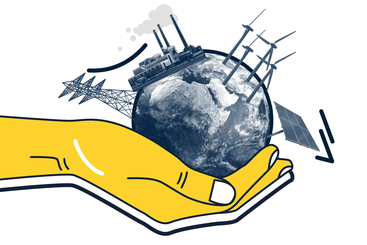The IPCC Working Group II report has reminded us once again of the global costs of climate change. Every country will need to take action to help avoid the worst impacts, but who will pay, what kind of finance will be used, and how will actions be coordinated remain pressing (and contested) questions for the global community.
COP26 offered several answers to these questions. One of the most significant ideas was to establish “country platforms” that could unlock international, concessional finance to support low- and middle-income countries rapidly shift on to lower-carbon and more resilient development paths.
The Just Energy Transition Partnership with South Africa is currently the leading example of a country platform for climate action. But what is the South Africa “deal”, why is it important and what lessons are there to increase the chances of success?
South Africa’s political declaration – a big deal?
The Political Declaration on the Just Energy Transition in South Africa was accompanied by an initial pledge of $8.5 billion from international partners to help accelerate the transition from coal to cleaner electricity. High level representatives from the South African Government and its partners are now navigating politics on both sides to secure the details of the financing arrangements and implementation.
For South Africa, this is a chance to reform the energy sector and boost growth. Costly, unreliable energy has constrained industrial activity and job creation for years, contributing to crippling levels of unemployment and stagnating living standards. Securing international climate finance could help tackle this bottleneck, raising the resources necessary to decommission coal-fired power plants, retrain workers and stimulate private investment in renewable energy.
For the international community, it signals a step change in climate finance provision. It shows that the G7 is willing to provide concessional resources to middle-income countries where emissions are most likely to rise over the next 20 years. It’s also an opportunity to finally address longstanding criticisms that international climate finance is too marginal, too fragmented and too transactional to help countries strategically transform their economies in ways that are either less carbon-intensive or more resilient to climate shocks.
Ensuring that the Political Declaration is successful will be one of the most important priorities for the international community ahead of COP27 later this year. Progress in South Africa could convince other emerging economies such as India, Indonesia and Viet Nam that they too can achieve a low-carbon structural economic transformation with international support.
Lessons from the history of development assistance
Success is by no means guaranteed, as the details of the Partnership remain vague and many basic structures for coordination are still being put in place. Those that want the South African deal to succeed, and to be replicated elsewhere would do well to learn from past experiences supporting international development.
The key feature of a “country platform” is the combination of a political agreement to tackle a problem to mutual benefit, enabled by a significant package of concessional financing and coordination structures for both government and donors. There are clearly many parallels with the historical efforts to support debt relief and improve aid effectiveness, including the more recent work on “thinking and working politically”.
Experience with budget support suggest, for example, that one of the main challenges for a country platform will be to maintain commitment to shared goals. Energy sector reforms will take years, if not decades to implement, but donor financing is subject to shorter funding cycles and often lacks predictability. Equally the objectives shared today by the government and its partners may also fray as implementation raises new concerns and political priorities (and actors) change.
Many other lessons are influencing demands for a more “programmatic approach” and greater flexibility to respond to the (ever changing) context different countries. The Taskforce on Access to Climate Finance, for example, wants to promote a new programmatic approach to climate finance based on countries’ own national climate action plans and priorities.
However, the Taskforce focuses on reducing transaction costs and unlocking climate finance for countries such as small island states that are highly vulnerable to the impacts of climate change. The only country platform to date – South Africa – focuses on mobilising finance for low-carbon structural change in an upper-middle income country.
Both of these COP26 initiatives have important but distinct roles to play in the climate finance ecosystem, alongside issues such as reform of multilateral development banks to improve climate alignment.
Cooperating with the private sector
In that spirit, it is important that country platforms aren’t seen as a simple extension of the aid effectiveness agenda. Many of the successes associated with budget support and debt relief for low-income countries have come from scaling up public spending on public goods such as health and education – not transforming different sectors of the real economy.
Delivering a just energy transition is an inherently complex and expensive undertaking that will require the involvement of the private sector, particularly to scale renewable energy generation and energy storage and to upgrade transmission and distribution infrastructure.
Experiences with industrial policy suggest that governments rarely succeed in steering investment behaviour using technocratic top-down plans. Instead, success depends on strategic collaboration between the government and private sector to jointly identify and address barriers to private investment (e.g. policies and regulations, project development/preparation, financial channels).
Country platforms may be able to strengthen this type of consultation and coordination and in doing so help to mobilise private capital at scale. For example, Development Finance Institutions can use the platform to make investments in developing countries more accessible to institutional investors by aggregating projects to meet the large ticket size investment requirements of these investors.
However, this idea is mostly untested in South Africa’s country platform, and close and continuous interactions between government and private sector actors bring risks of state capture or poor decision making. At the very least, steps must be taken to ensure that government retains sufficient independence to be able to withdraw support for firms and sectors which are not meeting expectations.



